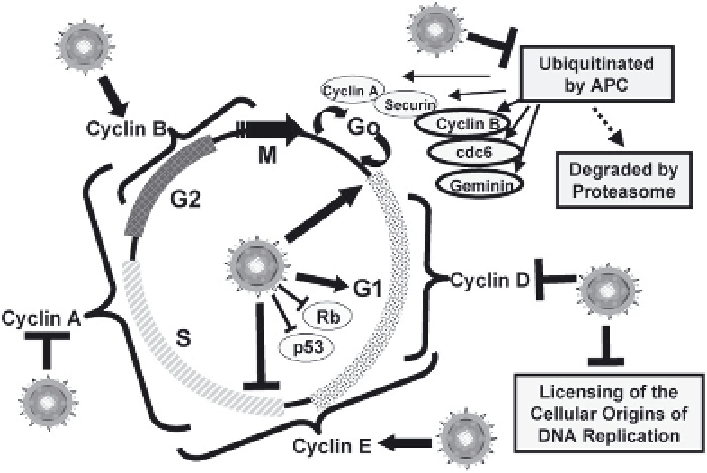Biology Reference
In-Depth Information
Fig. 1
Effects of HCMV on the cell cycle. The cell cycle is a tightly regulated process through
which the cell replicates its DNA and divides into two daughter cells. G
0
is the resting state, and
cells are stimulated through growth signals to express cyclin D and enter G
1
phase. During
G
1
phase, the anaphase-promoting complex (
APC
), an E3 ubiquitin ligase, remains active, and
proteins that are not needed by the cell until later in the cell cycle are ubiquitinated and targeted
for degradation by the proteasome. A prereplication complex (licensing) is established at cellular
origins of DNA replication and cyclin E is induced. Replication of the cellular DNA in S phase
requires cyclin A. G
2
phase follows S phase and marks the transition prior to cell division in
M phase. Both cyclin A and cyclin B are required during the G
2
/ M period. The major guardians
of the cell cycle are Rb and p53. Infection of cells during G
0
/G
1
phase induces progression through
G
1
. However, the normal expression of the cyclin-dependent kinases is disrupted, and the cell
cycle is blocked before the replication of cellular DNA. HCMV specifically inhibits the expres-
sion of cyclin D and cyclin A, but promotes expression of high levels of cyclin E and cyclin B. In
infected cells, the activity of the APC is blocked and licensing of the cellular origins of DNA
replication is inhibited. p53 is stabilized, but it cannot activate its target promoters, and the
inhibitory activity of Rb on the E2F/DP transcription factors is relieved
events by which the cell prepares for division (for review see Sherr 1996, 2000).
These events are regulated by heterodimeric kinases that consist of a regulatory
cyclin subunit and a catalytic subunit, the cyclin dependent kinase (cdk).
Multisubunit E3 ubiquitin ligases that target proteins for degradation by the protea-
some also regulate cell cycle progression. A resting cell (in G
0
phase) can be
induced to enter the cell cycle by a number of proliferative signals including growth
factors and serum stimulation. Initially, there is activation of the expression of the
D-type cyclins, which form kinase complexes with cdk4 or 6. The phosphorylation
of substrates by the cyclin D/cdk4 and cyclin D/cdk6 kinases releases the quiescent
cell from its resting state and permits entry into the G
1
phase of the cell cycle.
The G
1
phase is the period during which multiple transcription factors and genes
encoding proteins involved in nucleotide metabolism and DNA replication are
induced. In G
1
phase, there is a commitment to DNA synthesis and cell division if

